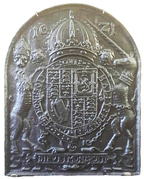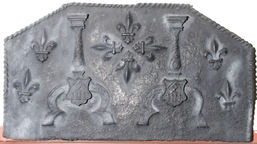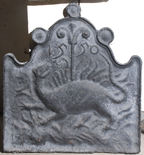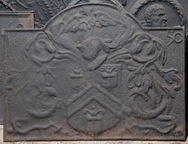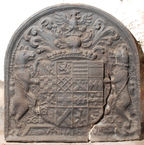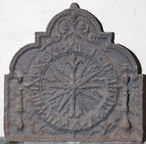-
301
Description: Rectangular; inset twisted rope edging (top and sides); crowned Tudor royal shield stamp repeated three times across top, each pair interspersed with an 'imp' figure with right arm raised; below each shield, rectangular stamp with indistinct ?rose design, each pair interspersed with a twisted rope saltire.
Notes: The crowned shield and 'imp' figure associate this fireback with others of the Royal series; the saltires may have apotropaic significance. Illustration from Starkie Gardner 1898, p. 143.
Arms: Tudor royal arms of England
- Decoration tags:
- rectangular (shape)
- none (edging)
- simple stamps
- carved stamps
- heraldic
- apotropaic
- armorial
- royal
- humans
- objects
Manufactured: in the mid-16th century in the Weald area of England.
Current location: Stone House, Rushlake Green, Warbleton, East Sussex, England.
Citation: Gardner, J. S., 1898, 'Iron Casting in the Weald', Archaeologia, 56, 1, pp. 133-164.
- Attached to series:
- Royal series
-
994
Description: Arched; cavetto-moulded edging; English royal Stuart shield, garter, crown, supporters, and motto on a cartouche; a monogram of S and C lies to the left of the Garter buckle; a small rose stamp is repeated each side of crown; date split each side of top of crown.
Notes: Although English arms, the design is in a continental style, arched firebacks being typical of Lorraine. In some later recastings the proportions have been distorted, making them narrower, and the '16' of the date is missing. The fireback illustrated was formerly in the city museum of Vlissingen in the Netherlands.
Copies of this fireback are known.
Inscription: 16 21 / HONI SOIT QVI MAL I PENSE / SC / DIEV ET MON DROIT
Arms: English Stuart royal (James I)
- Decoration tags:
- rounded arched (shape)
- cavetto (edging)
- whole carved pattern
- heraldic
- monogram
- armorial
- royal
- text
Manufactured: in 1621 possibly in the Ardennes area of Belgium.
Current location: not known.
Citation: Gardner, J. S., 1898, 'Iron Casting in the Weald', Archaeologia, 56, 1, pp. 133-164.
- Attached to series:
- Jacobean royal armorial firebacks
- Stuart royal armorial firebacks
-
370
Description: Fragment; left side only; twisted rope edging to left, canted moulded batten above; left hand print with dividers to its right.
Notes: An unusual combination of edging. The dividers may refer to the occupation of the person for whom this fireback was cast. Formerly in the collection of Dr C. L. Prince of Crowborough, Sussex.
- Decoration tags:
- rectangular with canted top corners (shape)
- rope and wood moulding (edging)
- simple stamps
- humans
- objects
Manufactured: in the mid- to late-16th century in the Weald area of England.
Current location: Anne of Cleves House, Southover High Street, Lewes, East Sussex, England.
Museum number: LH000.798 (part of the Sussex Archaeological Society museum group)
Citation: Anon., 30 Dec 1911, 'Sussex Backs and their Story', The Ironmonger.
Citation: Dawson, C., 1903, 'Sussex Iron Work and Pottery', Sussex Archaeological Collections, 46, pp. 1-54.
Citation: Gardner, J. S., 1898, 'Iron Casting in the Weald', Archaeologia, 56, 1, pp. 133-164.
- Attached to series:
- Hand print firebacks
- Metalware stamp firebacks
-
393
Description: Rectangular with canted top corners; twisted rope edging all round except base: plain plate with two stamps of an iron firedog with twisted neck and shield bearing letters HN and crossed staples; firedogs have columnar capitals; fleur de lys stamp repeated six times, singly at each end, in star pattern in middle; stamps have twisted wreaths.
Notes: The initials HN probably refer to Henry Nevill, the crossed staples being a badge of the Nevill family. Henry Nevill occupied Mayfield furnace from about 1585 until 1599. One of two variants (see no. 742) with the same firedogs and fleurs-de-lys; other firedogs in a very similar style are known. Formerly at Holmbush Farm, Hellingly, Sussex.
Inscription: HN HN
- Decoration tags:
- rectangular with canted top corners (shape)
- rope (edging)
- simple stamps
- carved stamps
- heraldic
- text
- objects
Manufactured: in the late-16th century possibly at Mayfield Furnace in the Weald area of England.
Current location: Anne of Cleves House, Southover High Street, Lewes, East Sussex, England.
Museum number: LH000.902 (part of the Sussex Archaeological Society museum group)
Citation: Anon., 30 Dec 1911, 'Sussex Backs and their Story', The Ironmonger.
Citation: Dawson, C., 1903, 'Sussex Iron Work and Pottery', Sussex Archaeological Collections, 46, pp. 1-54.
Citation: Gardner, J. S., 1898, 'Iron Casting in the Weald', Archaeologia, 56, 1, pp. 133-164.
-
407
Description: Quasi-arched rectangular shaped; unique, cavetto moulded edging, which loops upon itself three times. A mythical salamander shown in the flames which legend states it is able to resist; behind is what appears to be a palm tree, on either side of which the date is stamped.
Notes: The fireback has been incorrectly dated 1550 instead of 1650, which Schubert, following W. R. Lethaby, asserted was a forgery claiming indications that a ‘6’ had been erased. Undoubtedly the first '5' is more prominent than the other figures though the exact method by which it has been substituted is not clear. Corrosion to the bottom right corner may have obliterated a letter 'M' seen on another casting; presumably part of 'IM'.
Inscription: 1550
- Decoration tags:
- rectangular with ornate arch (shape)
- cavetto (edging)
- whole carved pattern
- individual numbers
- pictorial
- mythological
- text
- animals
Manufactured: in 1650 possibly at Brede Furnace in the Weald area of England.
Current location: Anne of Cleves House, Southover High Street, Lewes, East Sussex, England.
Museum number: LH000.901 (part of the Sussex Archaeological Society museum group)
Citation: Dawson, C., 1903, 'Sussex Iron Work and Pottery', Sussex Archaeological Collections, 46, pp. 1-54.
Citation: Gardner, J. S., 1898, 'Iron Casting in the Weald', Archaeologia, 56, 1, pp. 133-164.
Citation: Lethaby, W. R., 1 Oct 1926, 'English Cast Iron - I', The Builder, 131, no. 4365, pp. 537-8.
Citation: Schubert, H. R., 1957, 'A Forgery in Iron', Journal of the Iron & Steel Institute, 165, p. 125.
- Attached to series:
- Hooked '1' series
- Loop edged firebacks
- Brede group
-
429
Description: Arched rectangular shape with symmetrical floral scrolls on top; three horizontal plank lines; ovolo moulding all round edge of main panel; inscription along top edge of panel; central figure of a bearded man wearing knee-length coat, belted at waist, and holding a sledge hammer in his right hand, his left arm akimbo; both feet pointing to his right; various ‘tools’ of his trade arranged about him; (clockwise from top left) shield, the quarters containing a masonry hammer, a firedog, a weight, and a pair of pincers; the date split on either side of his head; a floral console supporting a shelf bearing a flagon, a tankard and a goblet; a fireback bearing the letters RL and a diamond shape; from the top of the fireback a dog leaping up at its master; between the man's legs a long-handled ladle, a weight and a cooking pot; a ringer, used to pull slag off molten iron; part of the elevation of a blast furnace, with wooden framework, casting house, and flames issuing from the top; an ore basket, wheelbarrow and a charcoal clamp
Notes: The 'Lenard' fireback; a much-copied plate. Items relating to the founder's working life are displayed to the left of the figure, those to the right reflecting his domestic life. Its individualistic design and naïve figuration are the key to identifying a distinct group of firebacks, all probably made at Brede. A pastiche of this fireback also exists (no. 668), with which it is sometimes confused. Inferior copies of this fireback were advertised in Kings Worthy Foundry's (Winchester) catalogue in the mid-20th century.
Copies of this fireback are known.
Inscription: RICHARD LENARD FOVNDER AT BRED FOVRNIS [each D is reversed] / 1636 / RL
- Decoration tags:
- rectangular with round arch (shape)
- ovolo (edging)
- whole carved pattern
- planklines
- pictorial
- historical
- text
- animals
- humans
- objects
Manufactured: in 1636 at Brede Furnace in the Weald area of England.
Current location: Anne of Cleves House, Southover High Street, Lewes, East Sussex, England.
Museum number: LH000.906 (part of the Sussex Archaeological Society museum group)
Citation: Anon., 30 Dec 1911, 'Sussex Backs and their Story', The Ironmonger.
Citation: Dawson, C., 1903, 'Sussex Iron Work and Pottery', Sussex Archaeological Collections, 46, pp. 1-54.
Citation: Gardner, J. S., 1898, 'Iron Casting in the Weald', Archaeologia, 56, 1, pp. 133-164.
- Attached to series:
- Brede group
- Personal firebacks
-
441
Description: Sub-rectangular; edged with a repeated length of helically-turned dowel (top and sides); apparently random arrangement of same piece of dowel repeated ten times, including a saltire and cross.
Notes: Apart from the Christian significance of the cross, the other arrangements of rope lengths may be apotropaic in their purpose, the double V being a possible invocation of the Virgin. The blemishes at the base are caused by the casting sand being disturbed by the pouring of the metal.
- Decoration tags:
- rectangular (shape)
- rope (edging)
- simple stamps
- apotropaic
- objects
Manufactured: in the 16th century in the Weald area of England.
Current location: Anne of Cleves House, Southover High Street, Lewes, East Sussex, England.
Museum number: LH000.799 (part of the Sussex Archaeological Society museum group)
Citation: Dawson, C., 1903, 'Sussex Iron Work and Pottery', Sussex Archaeological Collections, 46, pp. 1-54.
Citation: Gardner, J. S., 1898, 'Iron Casting in the Weald', Archaeologia, 56, 1, pp. 133-164.
- Attached to series:
- Rope design firebacks
-
459
Description: Arched rectangular shape; fillet edging; shield, helm, crest and mantling of the Worshipful Company of Blacksmiths; date in top corners; initials at bottom, below mantling.
Notes: One of the hooked ‘1’ series; unevenly impressed, the right more deeply than the left.
Copies of this fireback are known.
Inscription: 16 50 / I M
Arms: Worshipful Company of Blacksmiths
- Decoration tags:
- rectangular with round arch (shape)
- fillet (edging)
- whole carved pattern
- armorial
- text
Manufactured: in 1650 possibly at Brede Furnace in the Weald area of England.
Current location: Anne of Cleves House, Southover High Street, Lewes, East Sussex, England.
Museum number: 1933.34.046 (part of the Sussex Archaeological Society museum group)
Citation: Dawson, C., 1903, 'Sussex Iron Work and Pottery', Sussex Archaeological Collections, 46, pp. 1-54.
Citation: Gardner, J. S., 1898, 'Iron Casting in the Weald', Archaeologia, 56, 1, pp. 133-164.
- Attached to series:
- Livery company firebacks
- Hooked '1' series
- Brede group
- IM series
-
498
Description: Arched plate; ovolo moulding edging; shield, supporters, coronet, helm, crest and motto of Viscount Montague; quarterly Browne, Albini, Fitzalan, Fitzalan of Clare, Warren, Maltravers, Nevill, Montagu, Monthermer, Inglethorpe, Burghe, Delapole, Bradeston, Tiptoft, Charleton and Kent (Plantagenet); supporters: two bears collared and chained; the crest: an eagle, the wings elevated and displayed.
Notes: The arms of either the 2nd (Anthony-Maria Browne, succ. 1592-1629) or 3rd viscount (Francis Browne succ. 1629-1682) - the 1st viscount was a Knight of the Garter and no garter is shown; the style of the modelling bears similarities to that on the 1618 series of firebacks and may be the work of the same pattern-maker.
Inscription: 16 / VERITATE DUCE [Be led by Truth]
Arms: Viscount Montague
- Decoration tags:
- rounded arched (shape)
- ovolo (edging)
- whole carved pattern
- armorial
- text
Manufactured: in the late-16th to early-17th century in England.
Current location: Cowdray House ruins, Midhurst, West Sussex, England.
Citation: Dawson, C., 1903, 'Sussex Iron Work and Pottery', Sussex Archaeological Collections, 46, pp. 1-54.
Citation: Gardner, J. S., 1898, 'Iron Casting in the Weald', Archaeologia, 56, 1, pp. 133-164.
- Attached to series:
- Cowdray firebacks
- Personal armorial firebacks
-
512
Description: Double arched rectangular shaped; ovolo edging; central clock dial with Roman numerals separated by stops, sunburst inside, single hand with fleur de lys pointer; teardrop weights, with finials above, suspended from each side; symmetrical tendrils above; date split below dial.
Notes: One of the ‘hooked 1’ series of firebacks; two versions exist of this fireback, the other without finials above the suspended weights. Copies were advertised in Longden & Co.'s (Sheffield) catalogue c.1911, and the Carron Company's catalogue.
Copies of this fireback are known.
Inscription: I · II · III · IIII · V · VI · VII · VIII · IX · X · XI · XII / 16 5 [2]
- Decoration tags:
- rectangular with round arch (shape)
- ovolo (edging)
- whole carved pattern
- pictorial
- text
- objects
Manufactured: in 1652 possibly at Brede Furnace in the Weald area of England.
Current location: Penshurst Place, Penshurst, Kent, England.
Citation: Gardner, J. S., 1898, 'Iron Casting in the Weald', Archaeologia, 56, 1, pp. 133-164.
- Attached to series:
- Hooked '1' series
- Brede group

